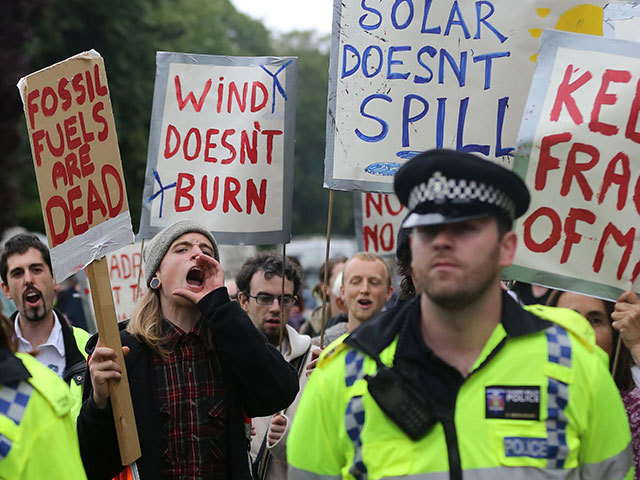
On February 26, Friends of the Earth put out a statement saying it is organising training days to “mobilise communities threatened with coal-bed methane and fracking”.
With less than one month to go until the UK’s first public inquiry into commercial unconventional gas extraction, FoE is running four such days to “help bring together communities to oppose the industry”.
The training days will take place in Annan, Stirling, Kilsyth and Glenrothes this month and next.
They will be joined by campaigners from south of the border, presumably including some who are trying to put paid to Cuadrilla, or indeed any other company that dare turn a drill-bit onshore.
According to an FoE campaigner, there are already protest groups mobilising against the revival of central belt hydrocarbons extraction . . . not shale oil, not coal, but gas, both shale and coalbed.
Basically, they’re out to destroy a prospective industry before it has even started, regardless of how unobtrusive it might turn out to be as lateral thinking and new techniques are applied to minimise environmental and community footprints.
Already, Reach CSG and Dart have met opposition. Besides the inquiry, in Dart’s case, the company is also confronted by the potential power of the web-based lobbying/bullying facilitator 38-Degrees.
I suspect that, if Dart has found attempts to prospect and lay the foundations of a gas production business onshore Scotland arduous thus far, then its management ain’t seen nothing yet; not once 38-Degrees really flexes its claws.
FoE is formidable too. This successful NGO has been around for a long time and it has many scalps tied to its belt. Many industries have been taken to task and often for very good reason; often traditional and generally environmentally dirty.
Natural gas is seen in two lights – that it is green and that it is dirty. In Norway it is dirty because more than 95% of that country’s power generation is hydro.
Here in Britain (and the US), there appears to be significant support among realists for the argument that gas, however derived, has green credentials and that it is a valid transition fuel as countries seek to reduce their carbon footprints “the easy way”.
Decent domestic production from shales especially could play a vital role in stabilising the very high energy prices in this country, and perhaps reducing them, if not dramatically then reasonably over time, especially as a substitute for the still huge quantities of coal being burnt by power stations.
There is a dangerous irony in all of this.
It really doesn’t seem to matter what form of energy is in the UK mix, all will attract criticism, frequently vehement and if not orchestrated by a major NGO like FoE then some other protest group.
A little bit of history.
How many of you recall the tail end of the hydro-electric dam building programme, whether in Scotland or elsewhere in Britain? I do!
I can recall protests that curtailed the hydro-power grand vision, especially in Scotland and Wales. Environment figured large in that debate, also the drowning of remote villages in the name of progress.
The net result is that the hydro potential of these isles has never been and never will be realised. At best, small schemes will get through, but that will be all.
Should anyone propose a major dam, all hell will break loose, you can bet on that even though it is also the most reliable and efficient green power generation technology at our disposal.
Try and build a large solar array.
Say you’re a farmer desperate to generate an additional strand to his business by filling a field with panels. Well, you can bet your last cent that your project will capture the interest of NIMBYs who will shed all reason and not be satisfied until they have killed your project.
And then there is the wind turbine, a technology avidly promoted by NGOs including, yes you’ve guessed it, by FoE and Greenpeace.
Despite such validations, seeking and securing planning permission for onshore windfarms in the British Isles has never been a walkover, notwithstanding the technology’s green credentials.
That said some fairly significant projects have made it through due process and been built; indeed ScottishPower’s Whitelee project is Europe’s largest onshore windfarm.
But as time passes, it gets progressively harder to get even small community projects through planning and built, such is the power of the “we hate windfarms” lobby, many of whom probably drive gas guzzling 4x4s .
For various reasons the UK Government though not yet Scottish, has kissed goodbye to its green energy targets as windpower becomes ever more bogged down, including by systematic protest.
Wave and tidal energy isn’t even out of nappies. Yet I sense they too will hit mounting protests; something that offshore wind is beginning to suffer in some measure.
North Sea oil and gas as an industry is regarded as the ultimate pariah, despite the fact that it has saved the UK economy as many as three times in the past 40/45 years.
And of course many people loathe nuclear though not necessarily for the same reason as I do.
Yes, I hold my hand up. I’ve always regarded nuclear as epitomising economics of the madhouse and of environmental and societal irresponsibility because of the nuclear legacy . . . the vast stockpile of radioactive waste that will saddle generations in perpetuity.
So what’s my point?
Somehow, we have to find a way through the tragic British energy shambles and arrive at a workable balance between the various forms of energy (including petro-chemical feedstock by the way) no matter the large downsides that, without exception, they all have.
If we don’t we’re sunk. The lights will go out. NIMBY’s will regret.
Recommended for you
